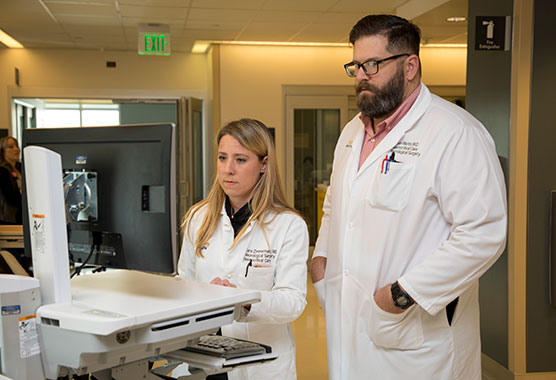Neurosurgery
UC Davis Health neurosurgeons perform advanced procedures to treat tumors, epilepsy, movement disorders and other neurological conditions.
Medically reviewed by Kiarash Shahlaie, M.D. on July 25, 2023.

World Class Neurosurgical Care
Neurosurgeons at the UC Davis Department of Neurological Surgery use the latest technology to perform advanced surgeries for complex neurological disorders.
Our internationally recognized team of neurosurgeons specializes in the latest brain and spine procedures. When possible, our team performs minimally invasive surgeries that promote a faster recovery. You may also benefit from our research and clinical trial opportunities.
Types of Neurological Surgery
UC Davis Health neurosurgeons have expertise in all types of complex brain and spine procedures. When possible, you undergo minimally invasive procedures that promote a faster, less painful recovery.
Cerebrovascular Treatments
We offer various treatments for different types of cerebrovascular disease. Our surgeons can close off brain aneurysms with metal clips (clipping). They can shrink arteriovenous malformations (AVMs) with radiation (radiosurgery). They can also perform carotid endarterectomy, removing plaque stuck inside your carotid artery to treat carotid artery disease (CAD) and lower your stroke risk.
Deep Brain Stimulation (DBS)
DBS uses a device to send electrical stimulation to electrodes implanted in the brain. Experts in our DBS Program use this treatment for patients with epilepsy, tremor, and movement disorders like Parkinson’s disease.
Minimally Invasive Neurosurgery
Neurosurgeons at our Minimally Invasive Neurosurgery (MINS) Program perform keyhole craniotomies. They remove skull base tumors and brain tumors through natural corridors like the nose or through small incisions in your eyebrow or behind your ear.
Spinal Neurosurgery
Our neurosurgeons partner with orthopaedic specialists at the UC Davis Spine Center to treat spinal tumors, spine trauma, degenerative spine conditions and other neuro-spinal disorders.
Request an Appointment
As Sacramento's No. 1 hospital, you'll benefit from unique advantages in primary care and specialty care. This includes prevention, diagnosis and treatment options from experts in 150 specialties.
Referring Physicians
To refer a patient, submit an electronic referral form or call.
800-4-UCDAVIS
Patients
Call to make an appointment.
Consumer Resource Center
800-2-UCDAVIS
Before you have neurosurgery, your care team will discuss how to prepare and what to expect during and after the procedure. It is important to follow your provider’s instructions to ensure the best outcome.
-

Before Neurosurgery
Neurosurgery preparation varies depending on the surgery type and underlying condition. You may not be able to eat, drink or take medications before surgery.
-

During Neurosurgery
Our anesthesiologists specialize in pain management for patients undergoing neurosurgery. The type of neuroanesthesia depends on the procedure. Most operations are performed under general anesthesia. In rare cases, we may numb the surgical site so you don’t feel pain but can still talk to your care team during some brain tumor surgeries.
-

After Neurosurgery
Your recovery takes place in our neurosurgical intensive care unit (NSICU). This unit has advanced neurological monitoring and a specialized care team to aid your recovery. Your length of stay depends on your progress. Some patients need inpatient neurological rehabilitation at the UC Davis Rehabilitation Hospital before going home.
Home Care After Neurosurgery
Everyone’s recovery experience after neurosurgery is unique. It is important to rest and follow your care team’s instructions.
Continue Your Medications
Follow your provider’s instructions and take medications for pain and other symptoms as prescribed.
Participate in Rehabilitation
Our outpatient physical therapy services and programs help you regain strength, endurance and mobility after neurosurgery. Some patients also benefit from occupational therapy and speech therapy.
Take It Easy
Your provider will let you know when you can resume everyday activities like driving and exercising. You shouldn’t lift heavy items or try to do too much.
When to Contact Your Neurosurgeon
You should call your physician if you experience seizures, severe head pain, limb weakness, speech problems or signs of infection, such as fever and chills.

Ranked among the nation’s best hospitals
A U.S. News & World Report best hospital in cardiology, heart & vascular surgery, diabetes & endocrinology, ENT, geriatrics, neurology & neurosurgery, and pulmonology & lung surgery.

Ranked among the nation’s best children’s hospitals
U.S. News & World Report ranked UC Davis Children’s Hospital among the best in pediatric nephrology, orthopedics*, and pulmonology & lung surgery. (*Together with Shriners Children’s Northern California)

Ranked Sacramento’s #1 hospital
Ranked Sacramento’s #1 hospital by U.S. News, and high-performing in aortic valve surgery, back surgery (spinal fusion), COPD, colon cancer surgery, diabetes, gynecological cancer surgery, heart arrhythmia, heart failure, kidney failure, leukemia, lymphoma & myeloma, lung cancer surgery, pacemaker implantation, pneumonia, prostate cancer surgery, stroke, TAVR, cancer, orthopedics, gastroenterology & GI surgery, and urology.

The nation’s highest nursing honor
UC Davis Medical Center has received Magnet® recognition, the nation’s highest honor for nursing excellence.

World-class cancer care
One of ~59 U.S. cancer centers designated “comprehensive” by the National Cancer Institute.

A leader in health care equality
For the 13th consecutive year, UC Davis Medical Center has been recognized as an LGBTQ+ Healthcare Equality Leader by the educational arm of America’s largest civil rights organization.

